9 Top Travel Marketing Trends to Help Your Brand Reach its Destination (+ Examples & Tips)
- Home
- Intelligent Insights Blog
- 9 Top Travel Marketing Trends to Help Your Brand Reach its Destination (+ Examples & Tips)
Who wants to stay home when there’s so much to see and do across the globe?
If you operate a travel company, your services will always be in demand. But you’re not the only travel brand on the market.
The travel industry is highly competitive, with countless options available to consumers. So, successfully marketing your travel brand requires standing out.
It’s not an easy feat.
But with the right strategies in place, your travel brand can become the top-notch, go-to destination for consumers.
Educating yourself on the latest travel marketing trends is the first step. However, implementing them will require you to be adaptive and open to innovation.
There are many benefits to keeping an ear to the ground on these trends. You stay ahead of the competition, build rapport with consumers, and much more.
If you’re not sure where to begin, don’t worry.
We’ve outlined 9 of the top trends in travel marketing. Plus, we offer examples of how these trends work and tips on how to make them work for you.
Ready to give your travel marketing and PR strategy an upgrade?
Let us help! Simply book a free consultation with one of our PR and marketing experts. We will take a look at you current mix to see where it could benefit from these travel marketing trends.
Travel Marketing Trends 2024
- Public Relations
- Micro-Influencer Marketing
- Video Content
- Optimized Google Business Profile
- Eco-Friendly Tourism
- Augmented Reality and Virtual Reality
- Personalization
- User-Generated Content
- Social Media Marketing
1. Public Relations is an Excellent Way to Build a Good Reputation
In the travel industry, a good reputation is vital and can significantly influence customer decisions. That’s why public relations (PR) is one of the most important travel marketing trends.
PR helps you build and maintain a positive reputation through consistent brand messaging and responses to feedback.
Also, with the abundance of travel options available, credibility is key for customers to trust your company. PR can help you build a positive reputation through media placements, mentions, and influencer relationships.
PR strategies involve creating personalized and localized content that resonates with specific audiences. When it comes to the travel industry, timing is everything.
Start preparing your PR plan a year in advance. Align it with your travel company’s seasonal calendar. This involves crafting timely PR responses for travel events, offers, or news. Early pitching of press releases and content is crucial for securing journalists’ consideration.
Here is an example of a travel press release from Tripadvisor:
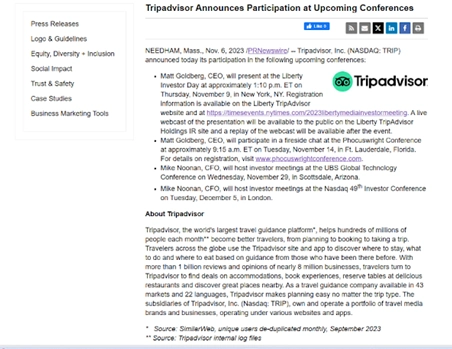
Pro Tip: Use PR to highlight local stories, traditions, and experiences that travelers can only find at your destination. This can include featuring local artisans, unique cultural events, or hidden gems that aren’t widely known. And remember, press releases are only one type of PR content.
PR isn’t always an easy undertaking. We can help you streamline the process and build a positive brand image. Learn more by booking a free demo.
Ready to start your PR strategy? Need some ideas to get started? See our article: 18 Top PR Trends Shaping the Industry in 2024
2. Micro-Influencer Marketing Can Help You Reach Your Target Audience
About 11% of adults follow travel influencers. But not just any influencer will do.
Micro-influencers typically have higher engagement rates compared to macro-influencers, placing collaboration with them among the top travel marketing trends.
Their smaller audience size tends to foster a more personal and authentic connection. This can lead to higher levels of interaction.
Plus, micro-influencers often cater to niche markets, making them ideal for targeting specific segments of the travel market. This may include luxury travel, budget backpacking, adventure tourism, or cultural experiences.
Additionally, micro-influencers can provide tailored content that resonates deeply with their followers. These followers often share similar interests.
Start by using specific Google searches or hashtag searches on social media platforms to find influencers relevant to your brand. This can include “adventure travel influencers” or “luxury travel influencers.”
Instead of scripted or overly promotional content, encourage influencers to share genuine experiences. Authentic storytelling can resonate more with audiences.
Here is an example of micro-influencer marketing in the travel industry:
Pro Tip: Evaluate micro-influencers’ engagement levels and ensure their followers are genuine and active. Additionally, utilize their authentic voice to share honest and detailed perspectives about travel experiences. This can be more influential than traditional advertising.
Think influencer marketing is right for your brand? Get more influencer tips by reading our article: 9 Top Influencer Marketing Trends Shaping the Industry in 2024
3. Video Content Showcases Your Travel Offerings
Travel is inherently about stories, and video is one of the top storytelling mediums. That’s why video content is one of the leading travel marketing trends for 2024.
Travel video content showcases the thrill of new experiences, the discovery of different cultures, and the personal transformations that occur on the journey. It leverages this natural storytelling aspect, which enables you to connect with audiences on a deeper level.
In the travel industry, customer engagement is critical. Video content marketing provides valuable and relevant information that keeps potential travelers engaged. This approach helps build a community of followers who are more likely to return for more information and bookings.
When leveraging video content, use high-quality video production. That includes a good camera (even smartphones can work in some situations), stable recording equipment, and external microphones.
Your video content should tell a story that resonates with your audience. It could be about the adventure, relaxation, culture, or unique experiences that a destination offers. Use compelling narratives to show the beauty and uniqueness of the location. Focus on what makes it different.
Below, you’ll find an example of video content in travel marketing:
Pro Tip: Use a variety of video types to showcase the diversity of experiences your travel brand offers. This can include destination guides, travel tips, promotional videos, and customer testimonials. You can also include videos that answer frequently asked questions.
For more video marketing ideas, check out our article: Top 10 Video Marketing Trends for 2024 [+ Tips]
4. An Optimized Google Business Profile Boosts Visibility
With billions of searches conducted daily on Google, Google My Business profile optimization has become one of the top travel marketing trends for 2024.
An optimized Google My Business profile increases the likelihood of your travel agency being discovered by potential customers. This profile appears in relevant search results, making it easier for travelers to find travel companies based on their search criteria.
It also helps lend credibility to your travel business. It displays important information such as contact details, customer reviews, and ratings. This transparency and availability of information can greatly influence a potential customer’s decision.
Start by claiming your Google My Business page. Even if Google has automatically created a listing for your business, you need to verify the information and optimize it.
Ensure that all details are accurate and fully completed. This includes your Name, Address, Phone Number (NAP), website URL, business category, and description. For example, if you run boat tours, select “Boat Tour Agency” as your category.
Here is an example of what travel marketing looks like on Google My Business:
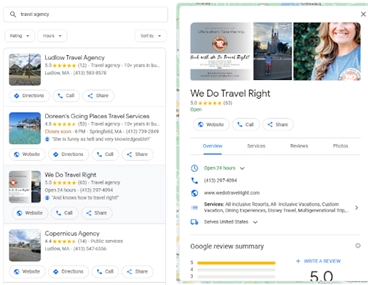
Pro Tip: Use the “Reserve with Google” feature. This allows potential customers to book and pay for tours directly from your Google My Business listing. This feature simplifies the booking process and can be an advantage for in-destination bookings.
SEO is a great marketing strategy for travel brands. Get more SEO ideas by checking out our article: 9 Essential Search Engine Marketing Trends for 2024 (+ Tips and Examples)
5. Eco-Friendly Tourism is the Latest Travel Craze
There’s a growing global awareness about eco-tourism. This places promoting eco-friendly tourism among the top travel marketing trends.
Many travelers are now more conscious of their ecological footprint and are seeking travel options that are less damaging to the environment. This shift in consumer behavior drives demand for eco-friendly travel experiences.
But what is it exactly?
Eco-friendly tourism often involves engaging with local cultures and communities in a more meaningful way. Many travelers today aren’t looking for superficial tourist activities. They want authentic experiences that offer a deeper connection to the places they visit.
Additionally, the trend towards health and wellness has expanded into the travel sector. Eco-friendly tourism often includes activities in nature. This aligns with the desire for healthful, outdoor, and wellness-oriented vacation experiences.
When marketing sustainable tourism services, it’s crucial to focus on a specific target audience. Research indicates that younger generations, particularly Gen Z and millennials, are most concerned about sustainable travel.
Your marketing should cater to the platforms and content styles preferred by these demographics. This can include using social media platforms such as TikTok and Instagram. It can also include creating content that resonates with their environmental and cultural values.
Earth Changers is one of the many eco-tourism companies promoting sustainability. Here is an example of what they offer:

Pro Tip: In your marketing materials, focus on the positive impacts travelers can make by choosing your services. For example, if your company contributes to conservation or local communities, articulate these impacts clearly.
6. Augmented Reality and Virtual Reality Provides Immersive Travel Experiences
Augmented reality (AR) and virtual reality (VR) are among the most innovative travel marketing trends. They both provide an immersive experience unmatched by any other digital technology. In fact, there’s a growing interest in travel AR and VR across the globe.
VR offers a highly engaging form of advertisement. It allows potential visitors to feel as if they are already at the destination before they book.
Meanwhile, AR can provide comprehensive guided tours around museums or exhibitions. This can enrich the visitor experience with additional information and interactive elements.
Additionally, AR technology can be used to create gamified tours. This often requires users to scan images to activate travel experiences or mini-games. This both entertains guests and increases dwell time at various locations.
This technology also allows users to go on virtual tours of famous landmarks while being in one place. They can get extra information while traveling to various locations. This “try-before-you-buy” method can significantly increase customer confidence and interest.
Try using VR to offer potential travelers a virtual tour of destinations, hotels, or experiences. Renderverse and Avatour are excellent VR tools for this.
With AR, create interactive guides that travelers can use at destinations. For instance, pointing a smartphone at a historical site could display information or stories.
Rock Paper Reality is one AR tool used for travel and tourism. Here is an example of what it looks like:
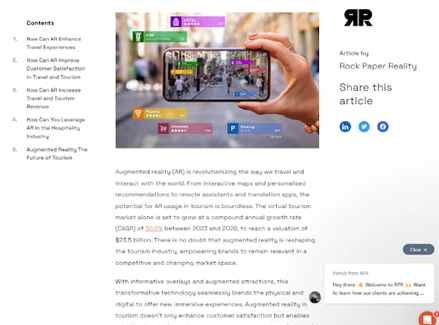
Pro Tip: Transform the booking process with VR. Allow customers to virtually explore different room types, amenities, or even travel options. This allows customers to make more informed purchasing decisions as they shop.
Want to see how you can further integrate new tech into your marketing and PR strategies? Learn more here: 8 Marketing Technology Trends That Can Supercharge Your Marketing Efforts
7. Personalization is Key to Turning Consumers Into Customers
Why is personalization one of the leading travel marketing trends? It allows travel companies to tailor their services and communications based on individual preferences and behaviors. This strategy leads to a more satisfying and relevant experience for customers.
By providing personalized experiences, you can engage customers more effectively. This often translates into enhanced customer loyalty. Customers are more likely to return to a brand that understands their preferences and provides customized experiences.
How can you get started on personalization as one of your travel marketing trends?
First, you’ll need to gather customer data. AI and data analytics enable you to gather, analyze, and act on vast amounts of customer data. You can use this data to predict customer preferences and behavior.
Be sure to collect zero-party and first-party data. This can include information directly shared by customers and data gathered from interactions with your brand. Use this data to understand customer behavior in real-time.
Once you’ve collected your data, use it to segment your email list and social media followers based on interests, behaviors, location, etc.
This enables you to create content that resonates with each group. For example, you can send location-specific offers to customers based on where they live or their destination preferences.
Using quizzes is a great way to send personalized travel content to potential customers. Here is an example from Conde Nast Traveler:
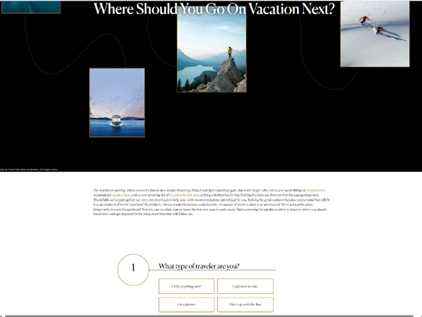
Pro Tip: Employ dynamic content in your emails to customize parts of your message for different subscriber groups. This approach allows you to send one email but tailor certain sections, such as offers and images.
Using AI can boost your PR and marketing efforts across the board. Want to see how others are using it? Check it out: 8 AI Marketing Trends for 2024 and Beyond (+ Tips & Ideas)
8. User-Generated Content Lends Credibility to Your Travel Brand
User-generated content (UGC) offers a level of authenticity that traditional marketing methods can’t match. That’s why it’s one of the top travel marketing trends.
When potential travelers see real photos, videos, and reviews from other travelers, it lends credibility to the travel experience you’re promoting. Unlike professionally created content, UGC is seen as more genuine and relatable.
For travel companies, UGC is a cost-effective marketing tool. It reduces the need for expensive photo shoots and ad campaigns because it leverages content that customers create. This helps save money, time, and resources.
Plus, content created by users tends to receive more likes, shares, and comments. This higher engagement rate boosts your travel brand’s visibility. Plus, UGC fosters a greater sense of trust and brand authenticity.
When garnering UGC, encourage customers to generate content that highlights particular aspects of your travel offerings. For example, a retreat leader might focus on the serenity of the destination. A tour operator could emphasize the excitement of activities.
Inform customers about the type of content you seek and explain how you will use it. Also, ensure that you have their permission to share it.
Testimonials are an excellent type of UGC. Here is an example of how they’re displayed on travel websites:

Pro Tip: Leverage UGC across multiple channels and formats for maximum impact. This can include featuring customer reviews on your website, creating social media feeds with curated customer content, and using customer images in recurring marketing campaigns.
Content marketing helps you inform your audience about your destinations. Want to see what’s trending? Learn more: 7 Top Content Marketing Trends 2024 [+ Tips and Tricks]
9. Consumers Often Use Social Media Platforms Before Booking Travel Destinations
Social media is one of the top travel marketing trends due to its vast global user base. And research shows that social media has the biggest influence on travel destination choices.
One of the reasons is that travel is a highly visual industry, and social media is an ideal platform for showcasing stunning images and videos. This visual appeal can capture the interest of viewers and inspire them to explore new destinations.
Plus, compared to traditional advertising methods, social media marketing is more cost-effective. Even with a limited budget, your brand can reach a large audience through targeted ads and organic content.
Not to mention, social media also allows you to engage with your audience in real time. You can respond to queries, gather feedback, and manage your reputation more efficiently.
How should you incorporate social media as one of your travel marketing trends?
Keep an eye on current social media trends and adapt them to fit the travel industry. Use interactive content, such as polls, quizzes, and challenges. You can also run contests and giveaways, which are popular and encourage participation.
It’s important to be genuine in your social media interactions. Share real travel photos and stories. Diversify your content to balance promotional material with lifestyle, destination, and activity posts.
Here is an example of social media marketing for travel companies from Intrepid Travel:
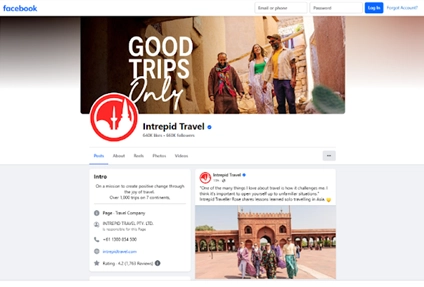
Pro Tip: If you have the budget for targeted advertising, consider using it. Platforms such as Facebook and Instagram offer sophisticated targeting options that can be very effective in travel marketing.
Not sure what’s currently trending? Need more ideas on how to leverage social media? Read our article: 9 Top Social Media Marketing Trends Taking the World by Storm
Key Takeaways on the Latest Travel Marketing Trends
The travel industry is crowded with options with many companies trying to stand out at the same time. Making your travel brand front and center requires unique and innovative marketing strategies.
However, it’s equally important to be flexible and open to implementing these trends in your strategies. This adaptability is key to staying relevant and appealing in the rapidly evolving travel market.
As a travel brand, you have a destination to reach: increased engagement and ROI. Consider these travel marketing trends as the fastest possible route to getting there. Give them a try and find out which ones work best for your travel brand.
Ready to get started? Not sure how to add these travel marketing trends to your mix? Let us help! Book a free consultation and we’ll look at how to boost your current strategy.

